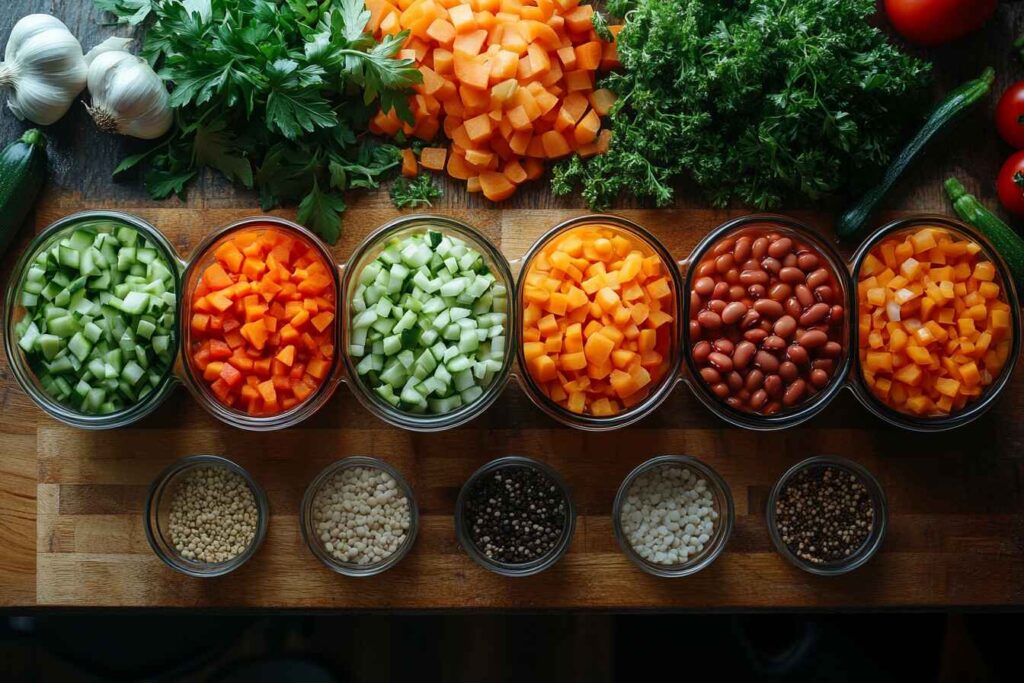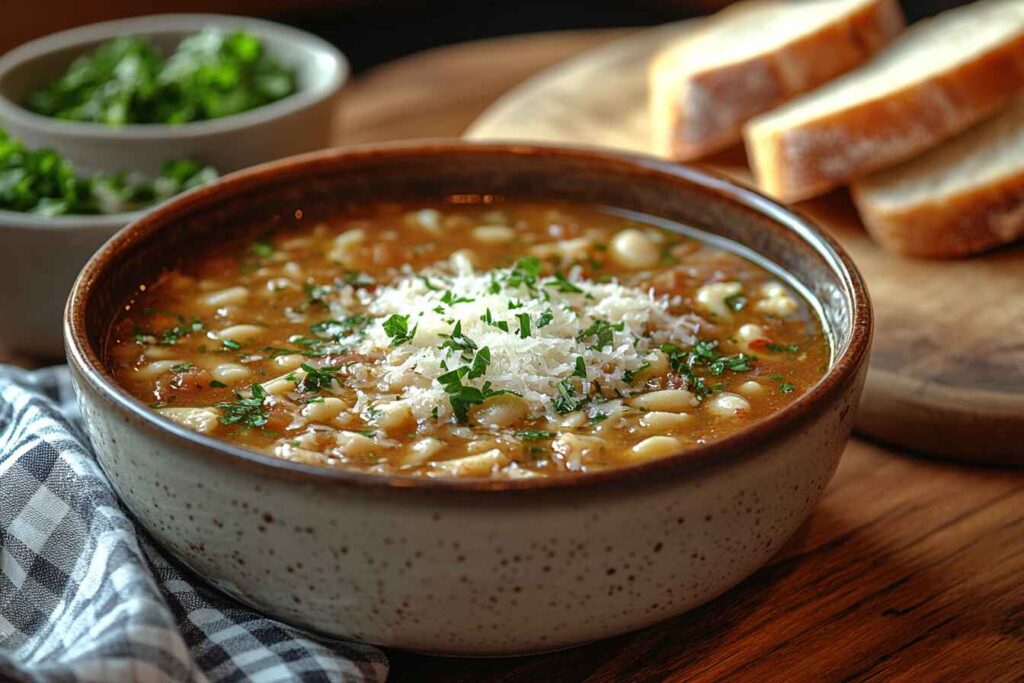Ever wondered what separates two classic Italian soups: Minestrone and Pasta e Fagioli? These hearty dishes often pop up on Italian restaurant menus, making you think they’re practically siblings. While they may seem similar at first glance, their differences are worth exploring. Think of them like cousins—related but with their own unique personalities.
In this article, we’re diving into the ingredients, flavors, cooking styles, and even the history of these two beloved soups. If you’ve been curious or confused, stick around because you’ll leave here with all your soup questions answered—and maybe even inspired to try making one at home!
“Italian cuisine is about simple ingredients, bold flavors, and a dash of love. Minestrone and Fagioli embody this perfectly!”
What is Minestrone?
Definition and Key Ingredients
Minestrone is like the “jack of all trades” of Italian soups. It’s a thick vegetable soup that’s incredibly versatile. Think of it as a canvas where you can add your favorite veggies, herbs, and even pasta or rice. Traditionally, it’s made with seasonal vegetables—whatever you’ve got on hand—and often includes tomatoes, beans, and sometimes meat. Minestrone is all about adaptability!
| Key Ingredients | Common Additions |
|---|---|
| Carrots, celery, onion, tomatoes | Beans, potatoes, zucchini |
| Pasta or rice | Spinach, kale, meat (optional) |
Origins and Evolution Over Time
The word “minestrone” comes from the Italian word minestra, meaning “soup.” Its roots go back to ancient Rome when people cooked hearty vegetable soups to feed their families. Over time, it evolved as new ingredients—like tomatoes and beans—were introduced to Italian cuisine. What makes it unique is how it reflects regional diversity. For example, northern Italy often uses rice instead of pasta, while southern recipes might include more tomatoes.
Common Cooking Techniques
Cooking minestrone isn’t complicated, but it does require patience. The magic happens when you layer the flavors step by step. Start by sautéing aromatic vegetables like onion, celery, and carrots—known as a soffritto. Then, add your tomatoes, broth, and tougher vegetables like potatoes or squash. Simmer until everything is tender, then toss in delicate greens or pasta at the end to avoid overcooking.
Variations of Minestrone Across Italy
Did you know there’s no one-size-fits-all recipe for minestrone? Each region in Italy has its twist. For instance:
- Tuscany: Minestrone often includes cannellini beans and a drizzle of olive oil.
- Ligurian: Pesto is stirred in just before serving for a fragrant, herbal touch.
- Venetian: Rice replaces pasta, making it heartier and creamier.

What is Pasta e Fagioli?
Definition and Key Ingredients
Pasta e Fagioli, which translates to “pasta and beans,” is the epitome of Italian comfort food. Unlike minestrone, it’s a simpler, bean-centric soup. Its core ingredients are pasta, beans (usually cannellini or borlotti), and a savory tomato base. What sets it apart is its creamy texture, often achieved by mashing some of the beans into the broth.
| Key Ingredients | Optional Enhancements |
|---|---|
| Cannellini or borlotti beans | Bacon or pancetta |
| Small pasta (ditalini or elbow) | Parmesan cheese, herbs |
Origins and Evolution Over Time
Pasta e Fagioli has humble beginnings as a “peasant dish.” It was born out of necessity, using pantry staples like beans and pasta to create a filling meal. Over time, it became a household favorite and even found its way to restaurant menus. Interestingly, its flavor can vary depending on where it’s made. Northern Italy might feature a creamier version, while southern recipes lean into tomato-forward broths.
Traditional Cooking Techniques
Making Pasta e Fagioli is all about maximizing flavor with minimal ingredients. It starts with sautéing garlic and onions in olive oil, sometimes with pancetta or bacon for extra depth. Then, beans and broth are added, followed by pasta. The key? Cook the pasta directly in the soup so it absorbs all those rich, savory flavors. Finish with a sprinkle of Parmesan or a swirl of olive oil.
Regional Differences in Pasta e Fagioli
Just like minestrone, Pasta e Fagioli has its regional quirks:
- Veneto: Creamier consistency, often achieved by pureeing half the beans.
- Campania: Uses a tomato-heavy base and fresh herbs like oregano.
- Sicily: Features a spicier kick with red pepper flakes.
Minestrone vs. Pasta e Fagioli: Key Differences
Now that we’ve explored the origins and ingredients of both soups, let’s get into the real question: What sets them apart? While they share some similarities, the differences lie in their textures, ingredients, and overall cooking methods. Think of it like comparing a big, colorful salad to a hearty, creamy stew—they serve different cravings!
Ingredients: What Sets Them Apart?
Both soups use beans, vegetables, and broth, but the proportions and primary ingredients differ. Minestrone is more of a vegetable-based soup with beans as an optional add-in, while Pasta e Fagioli is all about the beans.
| Aspect | Minestrone | Pasta e Fagioli |
|---|---|---|
| Main Ingredient | Vegetables | Beans |
| Broth Type | Tomato-based or clear broth | Thicker, sometimes pureed |
| Pasta or Rice? | Both are common | Always pasta |
| Consistency | Chunky, brothy | Creamy, thick |
Texture and Consistency: Thick vs. Brothy
If you love a soup that’s loaded with vegetables and feels light yet hearty, minestrone is for you. It has a brothy base with chunks of veggies and pasta. On the other hand, Pasta e Fagioli has a thicker, creamier texture because of the beans, which are often mashed or pureed into the broth.
Flavor Profiles: Herbaceous vs. Rich & Hearty
Minestrone is fresh and herbaceous, often featuring basil, thyme, or oregano. It can be bright, thanks to the acidity of tomatoes. Pasta e Fagioli, on the other hand, leans into a richer, more savory taste, especially when cooked with pancetta or bacon.
Cooking Methods: Simmering vs. Slow Cooking
Minestrone can be made relatively quickly—just a 30-minute simmer, and you’re good to go! Pasta e Fagioli benefits from a slower cooking time, allowing the beans to break down and create a richer texture.
Serving Styles and Accompaniments
Minestrone is often served with a drizzle of olive oil, fresh basil, or a sprinkle of Parmesan. Pasta e Fagioli is heartier, usually topped with grated cheese and sometimes even served with crusty bread to soak up the thick soup.

Common Mistakes When Cooking Minestrone and Pasta e Fagioli
Even experienced cooks can make a few missteps when preparing these soups. Avoid these common mistakes to ensure your soup turns out delicious every time.
Using the Wrong Type of Beans
Not all beans cook the same way! Using hard beans without soaking them properly can lead to a grainy texture. For Pasta e Fagioli, use cannellini or borlotti beans—they break down just right.
Overcooking or Undercooking Ingredients
Nobody likes mushy vegetables in minestrone! Add delicate ingredients like spinach or zucchini in the last few minutes of cooking so they retain their texture.
Choosing the Wrong Pasta Type
The shape and size of pasta matter! Small pasta like ditalini is best for Pasta e Fagioli, while short, sturdy pasta like penne or rotini works well in minestrone.
Not Balancing the Flavors Properly
Minestrone needs acidity from tomatoes or a splash of vinegar at the end. Pasta e Fagioli benefits from a pinch of red pepper flakes for depth. Don’t be afraid to adjust seasoning as you go!
Step-by-Step Guide to Making Minestrone
Ingredients
“Minestrone is like a warm hug in a bowl—full of veggies, pasta, and a whole lot of love.”
- 2 tablespoons olive oil
- 1 onion, diced
- 2 carrots, chopped
- 2 celery stalks, chopped
- 3 garlic cloves, minced
- 1 zucchini, diced
- 1 can diced tomatoes (14 oz)
- 1 can kidney beans (14 oz), drained
- 4 cups vegetable broth
- 1 cup pasta (small shapes like penne or macaroni)
- Salt, pepper, oregano, basil (to taste)
Instructions
- Heat olive oil in a large pot over medium heat. Sauté onion, carrots, and celery for 5 minutes.
- Add garlic and cook for another minute.
- Stir in diced tomatoes, kidney beans, and broth. Bring to a simmer.
- Add zucchini and pasta. Cook for 10-15 minutes until pasta is tender.
- Season with salt, pepper, and herbs.
- Serve hot with a sprinkle of Parmesan cheese.
Step-by-Step Guide to Making Pasta e Fagioli
Ingredients
- 2 tablespoons olive oil
- 1 small onion, diced
- 2 garlic cloves, minced
- 1 can diced tomatoes (14 oz)
- 1 can cannellini beans (14 oz), drained
- 4 cups chicken or vegetable broth
- 1 teaspoon Italian seasoning
- 1 cup ditalini pasta
- Salt, pepper to taste
- Parmesan cheese for garnish
Instructions
- Heat olive oil in a large pot. Sauté onion and garlic until soft.
- Add diced tomatoes, beans, broth, and Italian seasoning.
- Simmer for 20 minutes, mashing some beans for a creamier texture.
- Stir in pasta and cook until al dente.
- Season with salt and pepper, then serve hot with Parmesan cheese.
Nutritional Comparison: Which One is Healthier?
If you’re wondering which soup is the healthier option, the answer depends on what you’re looking for in a meal. Both minestrone and pasta e fagioli are packed with nutrients, but their calorie, protein, and fiber content differ slightly.
Calories, Protein, and Fiber Content
Minestrone, being mostly vegetable-based, tends to be lower in calories and higher in fiber. On the other hand, pasta e fagioli, with its rich bean content, provides more protein and a heartier texture.
| Nutritional Factor | Minestrone (per 1 cup) | Pasta e Fagioli (per 1 cup) |
|---|---|---|
| Calories | 180-220 kcal | 250-300 kcal |
| Protein | 6-8g | 10-12g |
| Fiber | 5-7g | 7-10g |
| Carbohydrates | 30-35g | 35-40g |
| Fat | 2-5g | 4-8g |
Best Soup for Weight Loss and Dieting
If you’re trying to eat light and load up on veggies, minestrone is the better choice. It’s naturally lower in calories, high in fiber, and keeps you full without being too heavy. Plus, you can skip the pasta and add extra greens to make it even healthier!
Minestrone vs. Pasta e Fagioli: Which One Should You Choose?
Best Soup for Cold Weather Comfort
On a chilly day, when you need something warm and satisfying, Pasta e Fagioli is the ultimate comfort soup. Its thicker, creamier consistency makes it feel like a full meal, perfect for cozy nights.
Which One is More Customizable?
If you love experimenting in the kitchen, minestrone wins! Since it’s all about seasonal veggies, you can switch up ingredients based on what’s fresh. Pasta e Fagioli is more structured, but you can still tweak it by adjusting the type of beans or pasta.
Conclusion
Final Thoughts on Italian Soup Classics
Both minestrone and pasta e fagioli have a special place in Italian cuisine. While minestrone is a colorful, veggie-packed dish, pasta e fagioli is a hearty, bean-based comfort food. They serve different moods and preferences, so why not try both?
Which One Should You Try First?
If you love fresh, vibrant flavors, start with minestrone. But if you’re craving something rich and satisfying, pasta e fagioli is your best bet. Either way, you’re in for a delicious, homemade Italian meal.
“At the end of the day, the best soup is the one that brings you warmth, comfort, and a little taste of Italy.”

